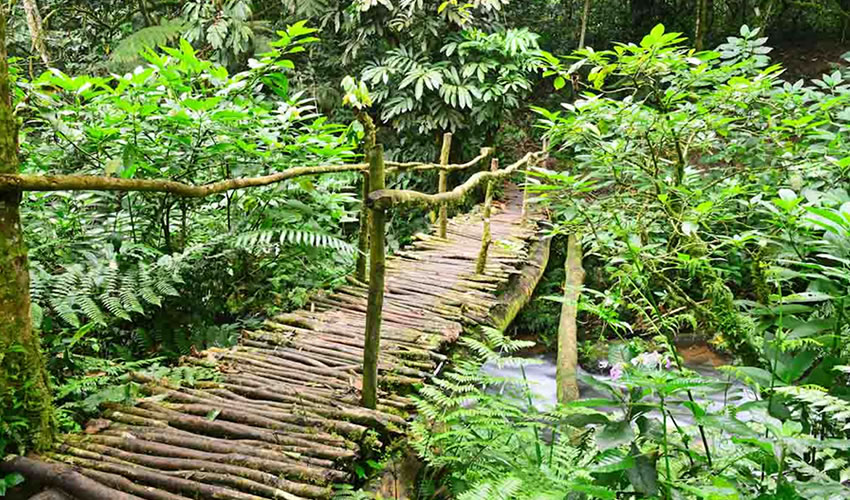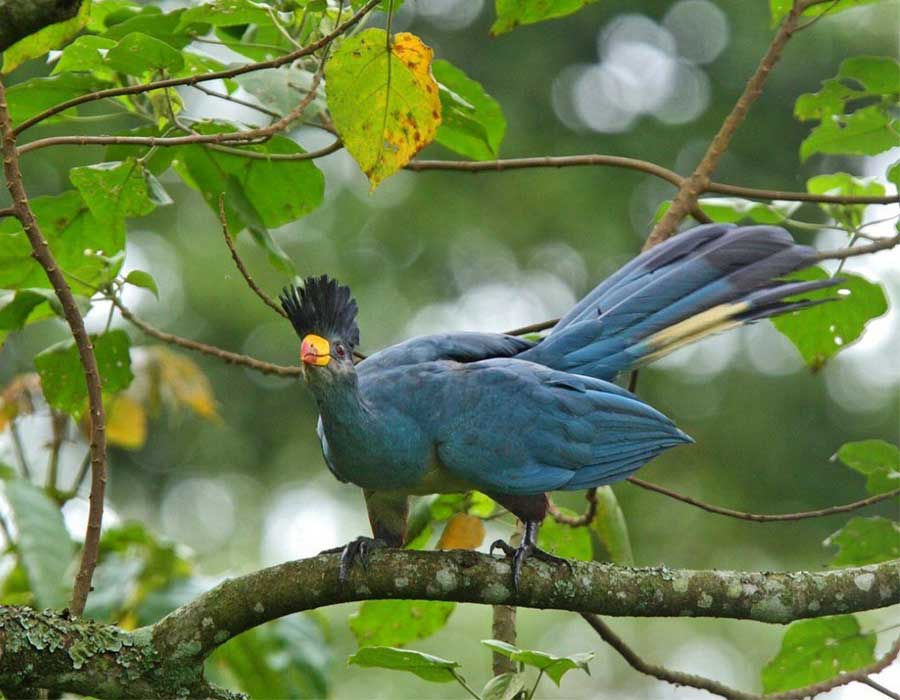Bigodi Wetland
The Bigodi Wetland Sanctuary is a captivating region situated in the Magombe wetland. This region is acknowledged for its enormous biodiversity, including many primate species such as the red colobus monkey, baboon, black-and-white colobus monkey, blue monkey, grey-cheeked mangabey, vervet monkey, red-tailed monkey, and L’Hoest monkey. Other mammals, including chimpanzees, Sitatunga, mongooses, bush pigs, otters, and bushbucks, also frequent this marsh, originating from the neighboring Kibale National Park.

The Bigodi Wetland Sanctuary exemplifies a community-based approach to natural resource management that can yield significant economic benefits for local inhabitants and the Ugandan safari sector.
The name “Bigodi” originates from the indigenous Rutooro term “kugodya,” which translates to ‘to stroll tiredly or wearily.’ It is presumed that when travelers arrived at the Bigodi swamp on foot, they were consistently too fatigued to continue to the jungle; hence, they opted to rest there.
The conservation of this swamp yields significant benefits, as it generates over $150,000 annually from tourism. A portion of these earnings was allocated to the construction of Bigodi Secondary School and a nursery school, as well as to the remuneration of the teaching staff; additionally, bridges have been erected over wetlands and streams inside the hamlet.
Cultural Village Walk: Explore the indigenous culture
Local guides provide visitors with services beyond guided nature hikes in the Bigodi Wetlands Sanctuary. Engage in a cultural adventure by seeing the picturesque villages surrounding Bigodi with a competent and amiable English-speaking field guide from the community.
The duration of the walk generally ranges from 3 to 4 hours, contingent upon the group’s pace. Based on your interests, you will initially consult a traditional healer who will gladly impart their knowledge of indigenous religions, herbs, flora, and local medicinal practices.
Bigodi is an avian paradise for ornithologists. Proficient birdwatchers can identify up to fifty novel species on a bird list. Currently, 138 bird species have been identified inside the Bigodi Wetland Sanctuary. Among the prominent avian species within the refuge is the magnificent Blue Turaco.
This wetland contains around 200 avian species, notably the renowned Great Blue Turaco (Corythaeola Cristata). The swamp is managed by the Kibale Association for Rural and Environmental Development (Kafred) and significantly benefits from the neighboring Kibale National Park, as various primates, including chimpanzees, periodically visit the swamp, enhancing the diversity of wildlife observed by tourists in Bigodi.
A Visit to Tinka’s Homestead
Engage with the local populace and immerse yourself in rural Uganda by residing at Tinka’s Homestead for one night, experiencing the lifestyle of the indigenous Batooro Tribe. The residence is managed by a community member who offers sleeping quarters, cultural instruction, entertainment, and traditional organic cuisine.
Experience authentic Ugandan cuisine prepared in the traditional Kitooro style at Tinka’s homestay. You will partake in breakfast, lunch, and dinner with the rural family and see their daily lifestyle. The lively Tinka family will permit you to exchange narratives and regional dances. Tinka’s homestead exemplifies an ideal equilibrium between comfort and traditional living.
Tinka’s homestay provides a thatched roof banda accommodating 3-4 guests, featuring a sitting area, a single bed, a double bed, and a balcony with a breathtaking view, for overnight stays. Two rooms are available, each featuring a private bathroom. Appreciate the vista from the balcony while indulging in African tea.
Birding in Kibale forest National Park
Birdwatching tours commence at 7 AM at Kanyanchu; advance reservations are recommended. Rare species encompass the Papyrus Gonolek, White-winged Warbler, White-collared Oliveback, and Papyrus Canary.
Bigodi Wetland Sanctuary, situated adjacent to the park, hosts 138 avian species observable on guided excursions along the boardwalk trail and observation platforms. Potential species encompass the White-spotted Flufftail, Yellow-spotted Barbet, Hairy-breasted Barbet, Yellow-billed Barbet, Western Nicator, Grey-winged Robin-chat, White-tailed Ant-thrush, Brown-backed Scrub-robin, Black-and-white Shrike-flycatcher, and Brown-throated Wattle-eye. Superb Sunbird, Brown-crowned Tchagra, Bocage’s Bush-shrike, Black Bishop, White-breasted Negrofinch, and Black-crowned Waxbill, among others.
Subsequently, you will have the chance to tour the residences of village elders and women who recount intriguing narratives concerning their traditional lifestyles, encompassing birth, marriage, rites, clans, and additional topics. You will also explore the historical context and issues confronting this impoverished community in rural Uganda.
During the journey, you will visit a local school and church, as well as experience Bigodi’s trading area, a vibrant center of rural life and commerce. The sanctuary’s field guides are consistently accessible to address any inquiries throughout the stroll.
A village walk in Bigodi Wetland Sanctuary is priced at USD 20 per individual, encompassing guide fees and an entrance ticket.
Kibale Forest National Park encompasses a total area of 560 square kilometers, characterized by a dense, lush forest in the north transitioning to a medium-altitude, moist, evergreen, semi-deciduous forest in the south, collectively comprising around 77 percent of the entire area. The remaining 23 percent comprises various plantations featuring exotic conifers, grasslands, and marshes. All these provide a variety of habitats for the numerous bird species inhabiting this area.
Kibale National Park is an expansive national park encompassing a significant area of rainforest and marshes that sustain a variety of flora and fauna. This tropical rainforest, characterized by its vibrant biodiversity and wetlands, is one of the most captivating woods in Uganda. Kibale Forest Park boasts a remarkable variety and abundance of primates, the highest in East Africa, as well as a diverse array of bird species.

The Guinea Congo forest biome has 82 species, alongside 32 species from the Afro-tropical highland biome, in addition to many rare species located in the highland regions. Included are the Bar-tailed Trogon, Fine-banded Woodpecker, Red-faced Crimson-wing, and White-bellied Crested Flycatcher. The park additionally supports 5 of the 32 constrained-range species in Uganda, along with 5 of the 12 Ugandan species endemic to the Lake Victoria biome.
Bird watchers at Kibale Forest National Park should be vigilant for the Nahan’s Francolin, an endangered species found in three additional forest reserves. Conversely, the Forest Ground Thrush has been documented in only two other Important Bird Areas (IBAs). Other intriguing species are the Black Bee-eater, Green-breasted Pitta, Yellow-spotted Nicator, White-thighed Hornbill, Yellow-ramped Tinkerbird, African Pitta, and Little Greenbul.
Birdwatching excursions in the park commence at 7 AM local time at Kanyanchu, and it is advisable for guests to reserve these tours in advance. Notable species to observe in this park include the Papyrus Canary, Papyrus Gonolek, White-collared Oliveback, and White-winged Warbler.
Bigodi Wetland Sanctuary, located adjacent to the park, is home to 138 bird species, best observed through guided tours along the boardwalk trail and from the viewing platforms. The species observed in this swamp include the Black-crowned Waxbill, White-spotted Flufftail, White-breasted Negrofinch, Yellow-spotted Barbet, Black Bishop, Hairy-breasted Barbet, Bocage’s Bush-shrike, Yellow-billed Barbet, Brown-crowned Tchagra, Black and White Shrike-flycatcher, Western Nicator, and Superb Sunbird. Grey-winged Robin-chat, Brown-throated Wattle-eye, White-tailed Ant-thrush, and Brown-backed Scrub-robin, among numerous other species.
